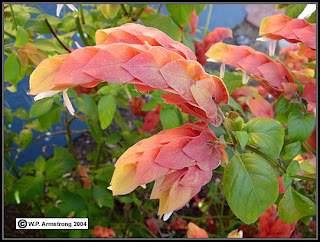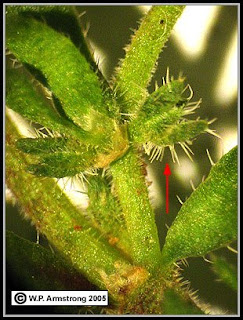
Swollen stems of
"desert trumpet" (Eriogonum inflatum var. inflatum).

A
"senita cactus" (Lophocereus schottii) south of the U.S. border in Sonora, Mexico. The gray, whisker-like spines on the upper stems suggest "old one" or senescence.

A
shrimp plant (Justicia brandegeana) in full bloom. Native to Mexico, this showy evergreen shrub belongs to the acanthus family (Acanthaceae). Formerly placed in the genus Beloperone, this interesting shrub is closely related to chuparosa (Justicia californica) of the Colorado Desert. Perhaps the next image will show its slight resemblance to a shrimp.

Flower-bearing spike of the
shrimp plant (Justicia brandegeana). Formerly placed in the genus Beloperone, this interesting shrub is closely related to chuparosa (Justicia californica) of the Colorado Desert. The tubular, white flowers spotted with purple are enclosed in showy, overlapping bracts.

The small fruits (silicles) of
"spectacle pod" (Dithyrea californica) resemble miniature eye glasses. This wildflower is common in sandy areas of the Colorado Desert.

The glistening, gland-tipped hairs
(trichomes) on the stem of the desert wildflower appropriately named
tackstem (Calycoseris wrightii) resemble minute translucent tacks. Magnification approximately 15x.
 Herniaria (Herniaria hirsuta)
Herniaria (Herniaria hirsuta) is a small annual herb in the pink family
(Caryophyllaceae).

A dried
"dune primrose" (Oenothera deltoides) held upright by the taproot. The outer branches have curled up to form the peculiar "lantern" or "bird cage".
 Naked Ladies (Amaryllis belladonna)
Naked Ladies (Amaryllis belladonna) These beautiful flowers grow out of bare, parched ground during September in San Diego County. They arise from deep-seated bulbs, long after the leaves from the previous spring have withered away.
 Owl's clover (Castilleja densiflora ssp. gracilis)
Owl's clover (Castilleja densiflora ssp. gracilis), formerly placed in the genus Orthocarpus. The individual flower superficially resembles an owl. White-flowered individuals can be found within large populations in coastal San Diego County.
 Stinkhorn Fungus (Phallus impudicus)
Stinkhorn Fungus (Phallus impudicus) This is a fowl-smelling fungus that attracts flies to its spore-laden, slimy head, thus increasing the odds of its spores being dispersed to new habitats. The fruiting body can appear almost overnight, and may "scent" your entire backyard.
 Steer's head (Dicentra uniflora)
Steer's head (Dicentra uniflora) on the Dana Plateau of the Sierra Nevada.

Eminent botanist Gilbert Voss in a dense stand of
golden eardrops (Dicentra chrysantha). Photograph taken on a recently burned slope of Tecate Peak in southern San Diego County (circa 1967).

These cone-like structures are the flower stalks of a seldom-seen wildflower called
"ground cone" (Boschniakia strobilacea). The small flowers protruding from the purplish scales are proof that these are not pine cones.

The inflated flower stalks of
"desert candle" (Caulanthus inflatus) appear on open flats and among shrubs in the Mojave Desert.

A genuine test tube cleaner (left) compared with three flower stalks of the infamous
"desert bottle cleaner" (Camissonia boothii ssp. condensata).
 Swollen stems of "desert trumpet" (Eriogonum inflatum var. inflatum).
Swollen stems of "desert trumpet" (Eriogonum inflatum var. inflatum). A "senita cactus" (Lophocereus schottii) south of the U.S. border in Sonora, Mexico. The gray, whisker-like spines on the upper stems suggest "old one" or senescence.
A "senita cactus" (Lophocereus schottii) south of the U.S. border in Sonora, Mexico. The gray, whisker-like spines on the upper stems suggest "old one" or senescence. A shrimp plant (Justicia brandegeana) in full bloom. Native to Mexico, this showy evergreen shrub belongs to the acanthus family (Acanthaceae). Formerly placed in the genus Beloperone, this interesting shrub is closely related to chuparosa (Justicia californica) of the Colorado Desert. Perhaps the next image will show its slight resemblance to a shrimp.
A shrimp plant (Justicia brandegeana) in full bloom. Native to Mexico, this showy evergreen shrub belongs to the acanthus family (Acanthaceae). Formerly placed in the genus Beloperone, this interesting shrub is closely related to chuparosa (Justicia californica) of the Colorado Desert. Perhaps the next image will show its slight resemblance to a shrimp. Flower-bearing spike of the shrimp plant (Justicia brandegeana). Formerly placed in the genus Beloperone, this interesting shrub is closely related to chuparosa (Justicia californica) of the Colorado Desert. The tubular, white flowers spotted with purple are enclosed in showy, overlapping bracts.
Flower-bearing spike of the shrimp plant (Justicia brandegeana). Formerly placed in the genus Beloperone, this interesting shrub is closely related to chuparosa (Justicia californica) of the Colorado Desert. The tubular, white flowers spotted with purple are enclosed in showy, overlapping bracts. The small fruits (silicles) of "spectacle pod" (Dithyrea californica) resemble miniature eye glasses. This wildflower is common in sandy areas of the Colorado Desert.
The small fruits (silicles) of "spectacle pod" (Dithyrea californica) resemble miniature eye glasses. This wildflower is common in sandy areas of the Colorado Desert. The glistening, gland-tipped hairs (trichomes) on the stem of the desert wildflower appropriately named tackstem (Calycoseris wrightii) resemble minute translucent tacks. Magnification approximately 15x.
The glistening, gland-tipped hairs (trichomes) on the stem of the desert wildflower appropriately named tackstem (Calycoseris wrightii) resemble minute translucent tacks. Magnification approximately 15x. Herniaria (Herniaria hirsuta) is a small annual herb in the pink family (Caryophyllaceae).
Herniaria (Herniaria hirsuta) is a small annual herb in the pink family (Caryophyllaceae). A dried "dune primrose" (Oenothera deltoides) held upright by the taproot. The outer branches have curled up to form the peculiar "lantern" or "bird cage".
A dried "dune primrose" (Oenothera deltoides) held upright by the taproot. The outer branches have curled up to form the peculiar "lantern" or "bird cage". Naked Ladies (Amaryllis belladonna) These beautiful flowers grow out of bare, parched ground during September in San Diego County. They arise from deep-seated bulbs, long after the leaves from the previous spring have withered away.
Naked Ladies (Amaryllis belladonna) These beautiful flowers grow out of bare, parched ground during September in San Diego County. They arise from deep-seated bulbs, long after the leaves from the previous spring have withered away. Owl's clover (Castilleja densiflora ssp. gracilis), formerly placed in the genus Orthocarpus. The individual flower superficially resembles an owl. White-flowered individuals can be found within large populations in coastal San Diego County.
Owl's clover (Castilleja densiflora ssp. gracilis), formerly placed in the genus Orthocarpus. The individual flower superficially resembles an owl. White-flowered individuals can be found within large populations in coastal San Diego County. Stinkhorn Fungus (Phallus impudicus) This is a fowl-smelling fungus that attracts flies to its spore-laden, slimy head, thus increasing the odds of its spores being dispersed to new habitats. The fruiting body can appear almost overnight, and may "scent" your entire backyard.
Stinkhorn Fungus (Phallus impudicus) This is a fowl-smelling fungus that attracts flies to its spore-laden, slimy head, thus increasing the odds of its spores being dispersed to new habitats. The fruiting body can appear almost overnight, and may "scent" your entire backyard. Steer's head (Dicentra uniflora) on the Dana Plateau of the Sierra Nevada.
Steer's head (Dicentra uniflora) on the Dana Plateau of the Sierra Nevada. Eminent botanist Gilbert Voss in a dense stand of golden eardrops (Dicentra chrysantha). Photograph taken on a recently burned slope of Tecate Peak in southern San Diego County (circa 1967).
Eminent botanist Gilbert Voss in a dense stand of golden eardrops (Dicentra chrysantha). Photograph taken on a recently burned slope of Tecate Peak in southern San Diego County (circa 1967). These cone-like structures are the flower stalks of a seldom-seen wildflower called "ground cone" (Boschniakia strobilacea). The small flowers protruding from the purplish scales are proof that these are not pine cones.
These cone-like structures are the flower stalks of a seldom-seen wildflower called "ground cone" (Boschniakia strobilacea). The small flowers protruding from the purplish scales are proof that these are not pine cones. The inflated flower stalks of "desert candle" (Caulanthus inflatus) appear on open flats and among shrubs in the Mojave Desert.
The inflated flower stalks of "desert candle" (Caulanthus inflatus) appear on open flats and among shrubs in the Mojave Desert. A genuine test tube cleaner (left) compared with three flower stalks of the infamous "desert bottle cleaner" (Camissonia boothii ssp. condensata).
A genuine test tube cleaner (left) compared with three flower stalks of the infamous "desert bottle cleaner" (Camissonia boothii ssp. condensata).